‘A Handful of Ghosts’ – ghost stories from the University Librarian
In October 1942, the University Librarian George H Bushnell, amused the University Celtic Society with a ghost story which, according to the society minutes, was ‘enjoyed by all, the room being quiet enough to hear a mouse squeak.’
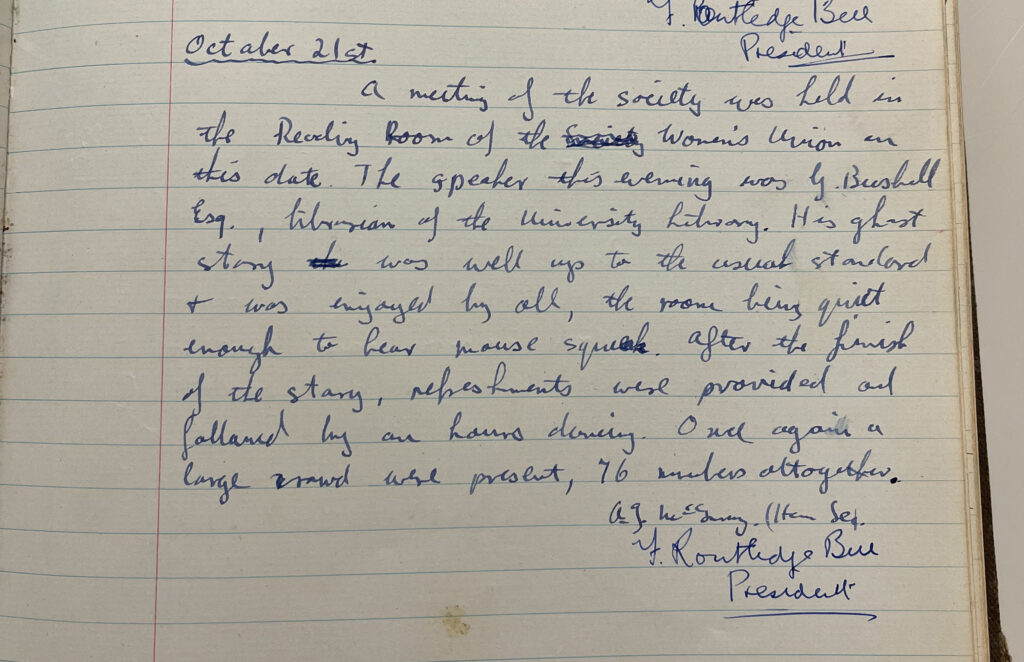
A few years later, in 1945, Bushnell published these stories as ‘A handful of Ghosts’, his only foray into non-fiction, dedicating the book to the Celtic Society ‘at whose meetings most of these stories were told by candle-light on a winter night’. The review of the book in the local newspaper, the St Andrews Citizen, praises his successful use of narrative verisimilitude, with the stories all based on Fife people and events. His daughter Loraine, a graduate of the Dundee College of Art, provided the cover illustration. The stories were republished in 1993 by the St Andrews Preservation Trust, with additional images by Loraine Scott (nee Bushnell). The University has copies of both in its Rare Book Collections.
The book contains five stories: ‘The Closing of the Cloisters’, ‘The Tenement’, ‘The Screaming Horsemen’, ‘The Shadow Man’ and ‘I Shall Take Proper Precautions!’ Bushnell keeps things close to home, referring often to his work as University Librarian and library collections, in a manner similar to M. R. James, who at times made manuscripts or books the focal point of his ghost stories.
‘The Closing of the Cloisters’, the longest, most gruesome, and perhaps best of the stories, draws upon University archives, though Bushnell takes some liberties with the truth.
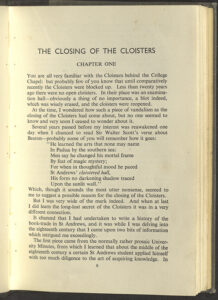
The opening of the story quotes Walter Scott’s The Lay of the Last Minstrel: A Poem, referring to St Andrews’ cloistered hall, a slight tweak to Scott’s original which is actually ‘St Kentigern’s hall’.
In the story Bushnell refers to the case of a student brought before Senatus in 1750 found guilty of filling ‘the capacious pockets of his scarlet gown with any books that he could carry off’. The case was a real one, though it took place in 1762. Patrick Bower, local bookseller, reported to the University that 63 books had gone missing from his shop (which was on the corner of Market Street and Church Street). Upon searching the College, the books were found in the room of student David Rattray, who confessed to having stolen them from Bower’s bookshop.
The list of stolen books has survived within the library archive and was published in Bushnell’s 1942 article on Patrick Bower in Transactions of the Bibliographical Society.
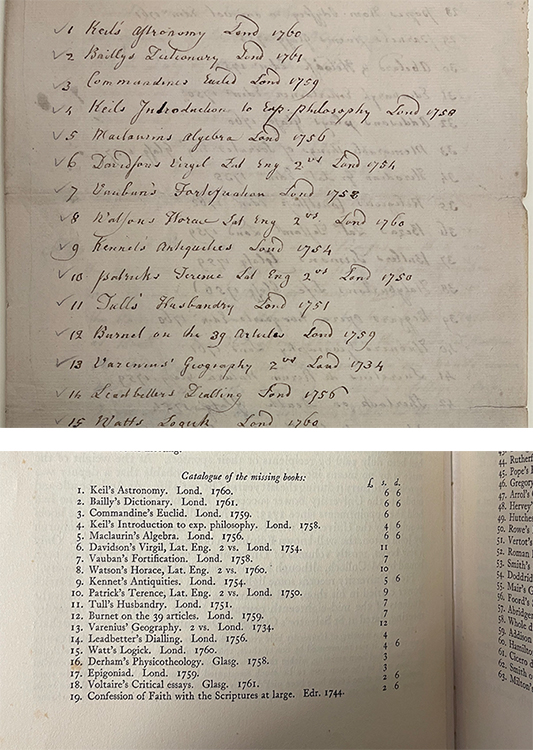
In the Bushnell’s fictional account, Senatus propose that the student return the books and be rusticated (suspended). One Professor X however has a more extreme punishment in mind – a night suspended on a hook in the cloisters! Appalled at the suggestion, a fellow Professor sarcastically suggested Professor X might like a night in the College cloisters himself – a challenge he accepts.
The screams and laughter rang through the cloisters, rang widely in the ears of the old Hebdomadar. Whether he heard, or was past hearing, the scuffling and scraping that followed, we shall never know. All that is certain is that when a terrible cackle echoed round the Quad, the Hebdomadar fainted.
Without revealing too many plot spoilers, the terrifying night Professor X endures in the cloisters is connected to another story from the University’s history – the skeleton in the library.
In 1707, a University messenger David Murray, took his own life. At the time this was considered an outrageous sin and as punishment his body was sent to Dundee for dissection and his articulated skeleton was kept in the Library (now the King James Library). Workmen were commissioned to make a case and an inscription in Latin was attached in 1714.
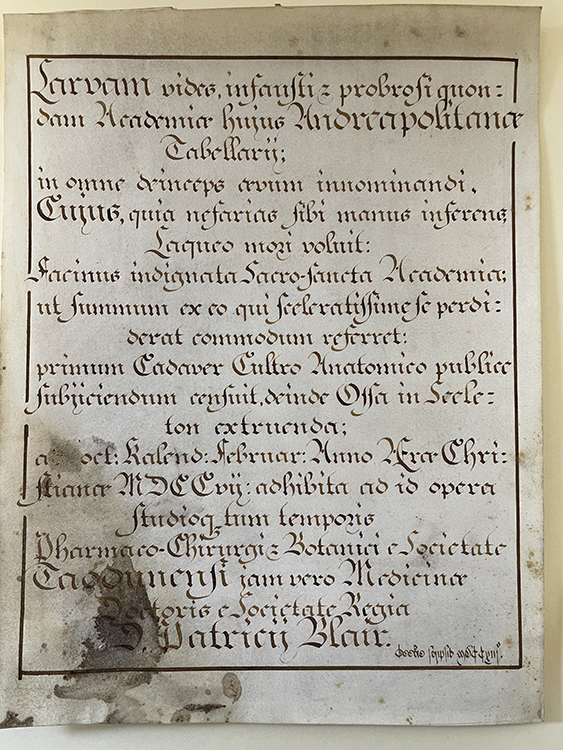
The inscription reads:
“You behold the remains of an unfortunate and infamous man, once the Messenger of this University of St Andrews and thereafter never to be named for all time to come: incensed at his monstrous action, in that he laid wicked hands upon himself and sought death by hanging, the sacred University, desiring to obtain the greatest advantage from one who had so criminally destroyed himself, resolved, first that his corpse should be publicly submitted to the dissecting knife, then that his bones should be articulated into a skeleton, on the 25th January in the year 1707 of the Christian Era; employing for that purpose the zealous services of one who at that time was Pharmacological-Surgeon and Botanist of the Dundee Society but now is a Doctor of Medicine of the Royal Society, Patrick Blair.”[1]
Bushnell and Dr J B Salmond, with the authority of University Court, had the skeleton removed from the library in 1941 and given a proper burial.
In Chapter two of Bushnell’s story, the characters of Johnson and Boswell enter on their famous tour around the country and their stop in St Andrews. Johnson expresses his exasperation at how “some vandal built up and closed the College Cloisters”. In conversation with Patrick Bower, they hear the story of Professor X and the skeleton. In the story the skeleton is located in the Hebdomadar’s room.
Boswell’s pale face was whiter than usual when the bookseller had finished the story, and he did not dawdle to admire South Street on the way back to the Inn!
The cloisters of St Salvator’s Chapel were in fact enclosed in the 19th century. While it makes for a gripping story it was for a less sinister reason than told in Bushnell’s story. The enclosed space was used for a variety of purposes from 1864, including an exam hall and as a gymnasium. The cloisters were opened up again as part of the work on the chapel in 1929-30.
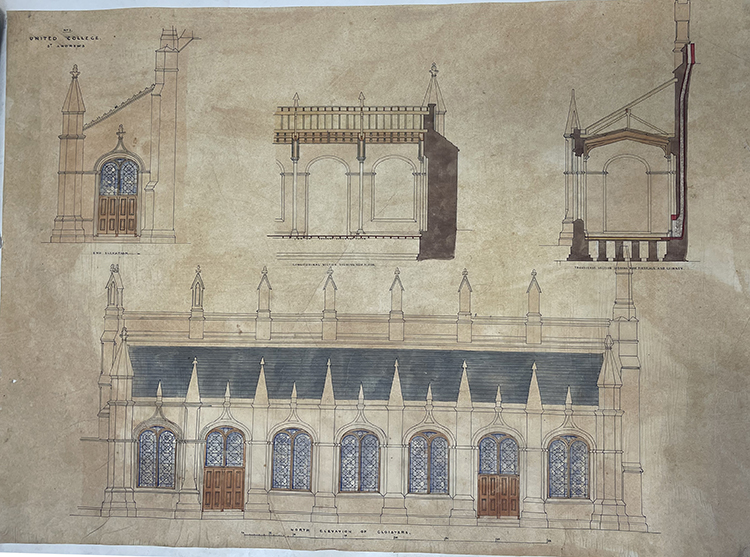
On this Halloween we leave you with Bushnell’s concluding words:
…If you stand in the cloisters at midnight even nowadays, you will sometimes hear vague noises around you – for all the world as if two people were racing past you …. tap, tap, tap, tap… creak, creak, creak, creak. And if you listen very carefully you may hear a medley of other sounds – faint cries, scuffling, cackles of earthly laughter. But the most persistent noises are the strange tap, tap, creak, creak. Of course, it is only the wind….
[1] Transcription by Norman Reid: https://news.st-andrews.ac.uk/archive/spookysaints/